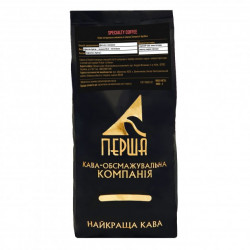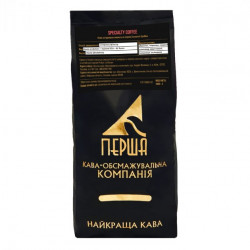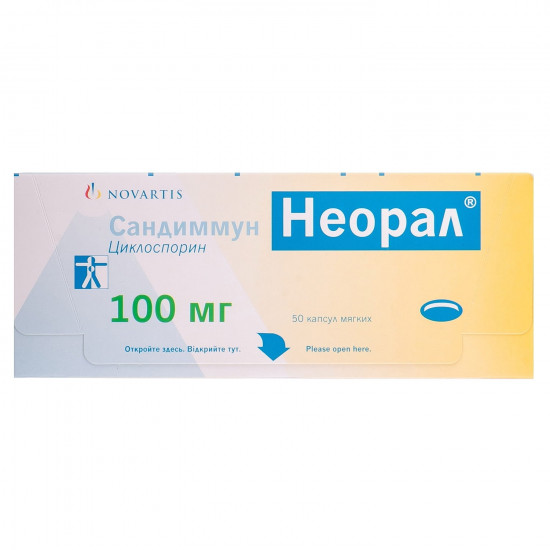
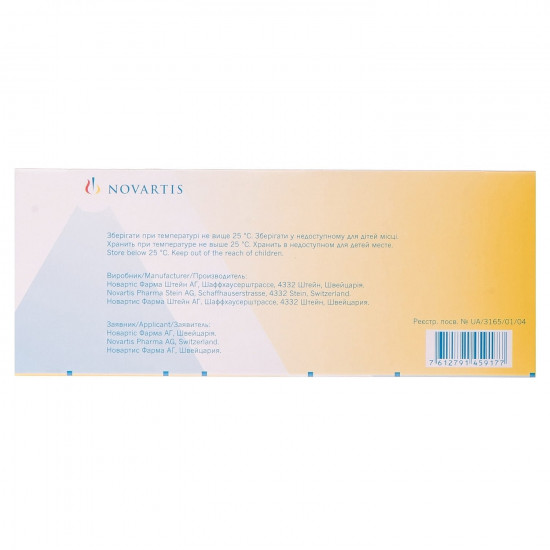
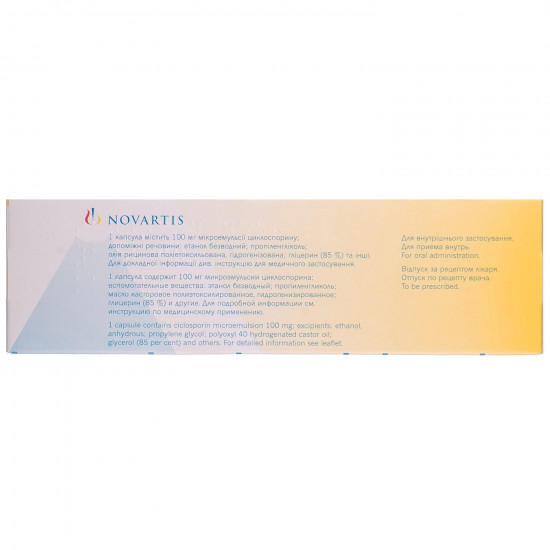



- Stock: In Stock
- Model: 179717
0% Customers recommend this product
-
5 Awesome0%
-
4 Great0%
-
3 Average0%
-
2 Bad0%
-
1 Poor0%
Reviews Over Sandimmun Neoral kaps. myagk. 100 mg No. 50
- (0)
Total Reviews (0)
click here write review to add review for this product.
Report this review.
Description
Pharmacological properties
Pharmacodynamics. cyclosporine (cyclosporine a) represents cyclic polypeptide which part 11 amino acids are. it is strong immunosuppressive medicine which at animals increases time of life of allografts of skin, heart, kidneys, a pancreas, marrow, small intestine and lungs.
bycarried out successful allogenic transplantations of solid bodies and marrow using cyclosporine for prevention and treatment of graft rejection and reaction "a transplant against the owner" at people. Cyclosporine was applied as at positive on a virus of hepatitis C (HVC), and HVC negative recipients of transplants of a liver. The significant favorable effect of cyclosporine is proved at patients with severe forms of psoriasis, atopic dermatitis, a pseudorheumatism and a nephrotic syndrome — states which cornerstone immunologic mechanisms can be.
Research on animals is shown that cyclosporine suppresses development of cell-mediated reactions. Cyclosporine blocks lymphocytes at rest in the phase G 0 or on early G 1 to a phase of a cellular cycle and suppresses release of lymphokines, including interleukin-2 (a growth factor of T-cages, TCGF). All available data confirm specific and reversible effect of cyclosporine on lymphocytes. It does not cause violations of a hematopoiesis and does not influence function of phagocytes.
Pharmacokinetics. Sandimmun Neoral — an advanced dosage form of active ingredient of cyclosporine. Sandimmun Neoral is a prekoncentrirovanny medicine of cyclosporine which is exposed to process of microemulsification in the presence of water, forming a form of drink or a form of liquid for introduction to a GIT. Sandimmun Neoral reduces the level of variability of pharmacokinetic indicators at one patient, providing more stable profile of absorption and smaller influence of at the same time eaten food and presence of bile. During pharmacokinetic and clinical trials it is proved that the interrelation between the minimum level of concentration (the C min ) and the general exposure (AUC) is much stronger at use of the medicine Sandimmun Neoral, than at administration of medicament Sandimmun. Thus, Sandimmun Neoral provides big predictability and the continuity of exposure of cyclosporine.
Available data show that after transition from administration of medicaments Sandimmun soft gelatin capsules and Sandimmun solution oral on use of the medicine Sandimmun Neoral in the ratio of doses of 1:1, C min in whole blood are comparable and remain within the target therapeutic range of the C min . In comparison with oral administration of medicine the Sandimmun (at whose application the C max in blood reaches during 1–6 w) the medicine Sandimmun Neoral it is quickly soaked up (owing to what average max t value 1 h less, and average value C max — is 59% higher) and shows bioavailability on average 29% above. During clinical trials with participation of the patients with transplants of a kidney who are on the supporting treatment the expressed correlation (r 2 ) between the C min and exposure (AUC) (0.8) is noted.
Cyclosporine is distributed bymainly in extravascular space. In blood of 33-47% of medicine there are in blood plasma, 4–9% — in lymphocytes, 5–12% — in granulocytes and 41–58% — in erythrocytes. In blood plasma about 90% of cyclosporine contact proteins, mainly lipoproteids.
Cyclosporine biotransformirutsya actively bywith formation about 15 metabolites. There is no uniform main metabolic way. Medicine mainly with bile, and only 6% of the dose accepted inside — with urine, is removed from them 0.1% of a dose — with urine in not changed look.
bynotes high variability of data on final T ½ cyclosporine depending on the applied method of the analysis and target population. Final T ½ is in range from 6.3 h at healthy volunteers up to 20.4 h — at patients with a serious illness of a liver.
Indication
Indication at transplantation
Transplantation of solid bodies. Prevention of rejection of transplants of a kidney, liver, heart, the combined cardiopulmonary allografts, allografts of a lung and pancreas.
Treatment of graft rejection at the patients who were earlier receiving other immunosuppressants.
Bone marrow transplantation. Prevention of graft rejection.
Prevention and treatment of reaction "transplant against the owner".
Indication, not connected with transplantation
Endogenous uveitis. The active, menacing to sight, average or back uveitis of a non-infectious etiology in cases when alternative treatment is inefficient or unacceptable.
Uveitis at Bekhchet's disease with repeated attacks of inflammation with involvement of a retina.
Nephrotic syndrome. The idiopathic steroidzavisimy or steroidrezistentny nephrotic syndrome (associated with adverse predictive factors) owing to the minimum changes at a glomerulonephritis, a focal segmentary glomerulosclerosis or a hymenoid glomerulonephritis at adults and children.
Induction or maintenance of remission.
Maintenance of the remission caused by glucocorticoids that does possible their cancellation.
Pseudorheumatism. Treatment of severe forms of an active pseudorheumatism when the standard prolonged specific therapy of this disease was inefficient or unacceptable.
Psoriasis. Severe forms of psoriasis when standard therapy is inefficient or unacceptable.
Atopic dermatitis. Short-term treatment (8 weeks) of severe forms of atopic dermatitis when standard therapy is inefficient or unacceptable.
Use
After an initiation of treatment medicine sandimmun did not shout, considering different bioavailability of various dosage forms of cyclosporine for oral administration, patients should not be transferred to any other oral dosage forms of cyclosporine, without having provided appropriate monitoring of concentration of cyclosporine in blood, creatinine level in blood plasma and hell. it does not concern dosage forms of medicine sandimmun did not shout soft gelatin capsules and sandimmun solution oral as these two forms are bioequivalent did not shout.
Taking into account differences in bioavailability of various oral dosage forms of cyclosporine important that doctors, druggists and patients knew that replacement of the medicine Sandimmun Neoral by any other dosage form of cyclosporine for oral administration is not recommended as it can lead to changes of concentration of cyclosporine in blood. For these reasons it is better to carry out appointments within one trademark.
Indication at transplantation
Organ transplantation
Initial dose makes 10–15 mg/kg of body weight, divided into 2 receptions and is applied at most for 12 h before transplantation. During 1–2 weeks after operation, medicine is appointed daily in the same dose then the dose is gradually reduced under control of concentration of cyclosporine in blood and function of kidneys to achievement of a maintenance dose of 2-6 mg/kg/days (in 2 receptions).
Sandimmun Neoral can be applied in a combination with other immunodepressants — corticosteroids and also as a part of the combined three- or four-component therapy. In an initiation of treatment it is possible to apply lower doses (for example the dose of 3-6 mg/kg/days inside distributed on 2 receptions). For monitoring of the minimum level it is better to investigate whole blood by means of a specific technique of the analysis. Target C min fluctuate depending on type of body, time which passed after transplantation and the immunosuppressive mode.
medicine Use Sandimmun the concentrate for preparation of solution for infusions is recommended toonly at those patients with transplants of bodies who are not capable to take the medicament Sandimmun Neoral inside (for example right after operation), or for patients with violation of absorption of oral dosage forms, for example during episodes of gastrointestinal frustration. However it is recommended to transfer patients to therapy by the medicine Sandimmun Neoral at once as soon as it allows their state (see information on medicament / short characteristic of medicine Sandimmun where the instruction for medical use of medicine Sandimmun a concentrate for preparation of solution for infusions is stated).
Transplantation marrow/prevention and treatment of reaction "a transplant against the owner"
Sandimmun a concentrate for preparation of solution for infusions usually give to Drug preference at the beginning of therapy though soft gelatin capsules and Sandimmun Neoral solution oral can use both the medicaments Sandimmun Neoral (see information on medicament / short characteristic of medicine Sandimmun where the instruction for medical use of medicine Sandimmun a concentrate for preparation of solution for infusions is stated).
Maintenance dose makes 12.5 mg/kg/days, divided into 2 receptions, and has to be applied during 3–6 (mainly 6) month. The dose is gradually reduced to zero. It can be in certain cases impossible to cancel Sandimmun Neoral, there will not pass year from the moment of bone marrow transplantation yet.
in the presence of gastrointestinal diseases which lead to decrease in absorption higher doses of capsules or a concentrate for in/in infusion Sandimmun can be required.
If the medicament Sandimmun Neoral is used at the beginning of therapy, the recommended dose makes 12.5-15 mg/kg/days in 2 receptions, since day before transplantation.
At some patients after medicament withdrawal Sandimmun Neoral can arise reaction "a transplant against the owner" which usually passes after therapy resuming. At its chronic course in a mild form it is necessary to apply Sandimmun Neoral in low doses to treatment of this state.
Indication, not connected with transplantation
Psoriasis
Taking into account variability of this disease the treatment has to be individualized. For remission induction the recommended initial dose makes 2.5 mg/kg/days, divided into 2 receptions; if in 1 month of treatment the improvement is noted, the dose is gradually raised at most to 5 mg/kg/days. Treatment needs to be cancelled if during 6 weeks of daily reception of 5 mg/kg/days it is not reached the sufficient answer or if the effective dose is not compatible to the following recommendations about safety. For patients whose condition demands especially fast improvement the initial dose of 5 mg/kg/days divided into 2 receptions is justified.
For maintenance therapy a minimal effective dose should be selected individually, it should not exceed 5 mg/kg/days in 2 distributed doses. Some clinical data confirming a possibility of cancellation of the Sandimmun Neoral medicament treatment after achievement of the satisfactory answer and resuming of therapy using it in the previous effective dose in case of approach of a recurrence are available. Continuous therapy can be required by some patients.
Atopic dermatitis
Recommended dose for adults makes 2.5-5 mg/kg/days, divided into 2 receptions, as much as possible — 8 weeks
If in 2 weeks the treatment response at an initial dose of 2.5 mg/kg/days is not satisfactory, a daily dose it is possible quickly povyst to the maximum 5 mg/kg. If against the background of reception of an initial dose of 2.5 mg/kg/days of the sufficient initial answer it is not possible to reach during 2 weeks, a dose it is possible to raise a maximum to 5 mg/kg/days quickly. In very hard cases of fast and adequate control of a disease it is possible to reach, applying an initial dose of 5 mg/kg/days in 2 receptions.
Pseudorheumatism
Is recommended to begin withSandimmun Neoral medicament treatment during the 12 weeks period. For the first 6 weeks of treatment the recommended dose makes 2.5 mg/kg/days inside, divided into 2 receptions. In case of insufficient effect the daily dose can be raised gradually if the shipping allows, but no more than up to 4 mg/kg/days Sandimmun Neoral it is necessary to cancel if after 3 months of treatment the improvement of a condition of the patient at application of the maximum resolved or tolerable dose is noted.
For maintenance therapy a dose should be titrated individually, depending on shipping. Sandimmun Neoral it is possible to appoint in combination with corticosteroids in low doses. Perhaps pharmakodinamichesky interaction between cyclosporine and NPVP therefore such combination should be applied with care.
Data on long-term use of cyclosporine for treatment of a pseudorheumatism are limited tonow. Thus, it is recommended to carry out repeated inspection of patients after 6 months of maintenance therapy and to continue it only provided that the advantage of treatment exceeds risks.
Nephrotic syndrome
For remission induction the recommended daily dose makes 5 mg/kg for adults and 6 mg/kg for children, divided into 2 receptions provided that, except for a proteinuria, kidney function is normal. For patients with a renal failure the initial dose should not exceed 2.5 mg/kg/days inside.
In a focal segmentary glomerulosclerosis useful.
Drug Sandimmun Neoral needs to be cancelled if the effect is absent within 3 months of application at treatment of a glomerulonephritis with the minimum changes and a focal segmentary glomerulosclerosis or 6 months — concerning a hymenoid glomerulonephritis.
For the supporting treatment the maximum recommended dose makes 5 mg/kg/days inside for adults or 6 mg/kg/days inside for children. Doses should be lowered gradually individually depending on efficiency indicators (proteinuria) and safety (first of all blood plasma creatinine) to the lowest effective level. Data on use of cyclosporine for long-term treatment of a nephrotic syndrome are limited. However during clinical trials the patients received treatment within 1–2 years. Long-term treatment can be performed if considerable reduction of a proteinuria when maintaining normal clearance of creatinine is noted and on condition of providing adequate precautionary measures.
Translation of patients with transplants from administration of medicament Sandimmun soft gelatin capsules or solution oral on administration of medicament Sandimmun NeoralAbsorption of cyclosporine from oral dosage forms of medicine Sandimmun is very variable
, and interrelation between a medicine dose the Sandimmun and exposure of cyclosporine (AUC) has nonlinear character. On the contrary, at use of the medicine Sandimmun Neoral the absorption of cyclosporine is less variable, and the interrelation between the C min and exposure is much closer, than at use of medicine Sandimmun.
Sandimmun on administration of medicament Sandimmun Neoral is recommended byWhen translating patients from administration of medicament initial recalculation of a dose in the ratio to 1 mg: 1 mg with the subsequent titration of a dose in case of need. Available data confirm that after such recalculation in the ratio 1 mg: 1 mg are reached comparable C min cyclosporine in whole blood thanks to what sufficient immunosuppression is supported. At many patients high maximum (peak) concentrations (the C max ) and increase in exposure of medicine (AUC) can be noted. A small part of patients when translating from medicine Sandimmun on Sandimmun Neoral can have a headache and paresthesias, connected as believe, with increase in exposure of cyclosporine. However other by-effects, including a renal failure, the pharmacokinetic indicators caused by such changes against the background of long-term treatment, it is not registered. The small share of patients can have more expressed these changes and gain clinical value. Their degree depends generally on individual ability to absorb cyclosporine from the medicament Sandimmun taken earlier. At such patients it is necessary to resort to a dose decline to reach the appropriate range of the C min .
Germinated long-term clinical observations patients with transplants was shown that at a considerable part of participants who at first accepted Sandimmun the maintenance therapy by the medicine Sandimmun Neoral can continue using the same doses, as at administration of medicament Sandimmun.
All patients needs to be observed according to the recommendations below.
1. Before the translation (that is against the background of administration of medicament Sandimmun). Definition of the C min cyclosporine, creatinine level in blood plasma and the ABP.
2. The 1st day. Transfer of the patient to the same daily dose of the medicine Sandimmun Neoral in which accepted Sandimmun for oral administration earlier (that is in the ratio 1 mg: 1 mg).
3. Days of the 4-7th after the translation. A control visit to the doctor for definition of the C min cyclosporine, creatinine level in blood plasma and the ABP.
4. Following control. Depending on data of the examination performed for the 4-7th day there can be a need for purpose of the next visits to the doctor (for example for the 2nd and 4th week) during the first 12 weeks after the translation of the patient on Sandimmun Neoral. During the visits to the doctor it is necessary to define the C min cyclosporine, creatinine level in blood plasma and the ABP and depending on these indicators to carry out the corresponding dose adjustment.
Translation of patients without transplants (that is with psoriasis, atopic dermatitis, a pseudorheumatism, a nephrotic syndrome) from administration of medicament Sandimmun soft gelatin capsules or solution oral on administration of medicament Sandimmun NeoralAbsorption of cyclosporine from oral dosage forms of medicine Sandimmun is very variable
, and interrelation between a medicine dose the Sandimmun and exposure of cyclosporine (AUC) has nonlinear character. On the contrary, at use of the medicine Sandimmun Neoral the absorption of cyclosporine is less variable.
byAfter the translation from administration of medicament Sandimmun on administration of medicament Sandimmun Neoral in equivalent doses high maximum (peak) concentrations (the C max ) and increase in exposure of medicine (AUC) can be observed. The small percent of patients can have more expressed these changes and gain clinical value. Their degree depends generally on individual ability to absorb cyclosporine from the medicament Sandimmun taken earlier. Therefore it is necessary to estimate a clinical condition of each patient prior to therapy by the medicine Sandimmun Neoral.
If though the slightest loss of effect can cause essential risk for the patient (for example at a pseudorheumatism), recalculation of a dose in the ratio is recommended to 1 mg: 1 mg when translating the patient from administration of medicament Sandimmun on administration of medicament Sandimmun Neoral. Other patients are recommended to appoint at first the medicine Sandimmun Neoral in a low initial dose with its corresponding titration depending on the clinical answer, creatinine level in blood plasma and the ABP.
At all patients who carry out transition with recalculation of a dose in the ratio of 1 mg: 1 mg, monitoring according to the recommendations below is required.
1. Before the translation (that is against the background of administration of medicament Sandimmun). Determination of level of creatinine in blood plasma and the ABP.
2. The 1st day. Transfer of the patient to the same daily dose of the medicine Sandimmun Neoral in which accepted Sandimmun for preoralny application earlier (that is in the ratio 1 mg: 1 mg).
3. The 2nd week. Determination of level of creatinine in blood plasma and the ABP and consideration of a possibility of a dose decline of the medicine Sandimmun Neoral if indicators significantly exceed level before transition.
4. The 4th week. Determination of level of creatinine in blood plasma and the ABP and consideration of a possibility of a dose decline of the medicine Sandimmun Neoral if indicators significantly exceed level before transition.
5. The 8th week. Determination of level of creatinine in blood plasma and the ABP and consideration of a possibility of a dose decline of the medicine Sandimmun Neoral if indicators significantly exceed level before transition.
6. The 12th week. Determination of level of creatinine in blood plasma and the ABP and consideration of a possibility of a dose decline of the medicine Sandimmun Neoral if indicators significantly exceed level before transition.
If, according to several definitions, creatinine level in blood plasma increases more than by 30% concerning level prior to medicament treatment Sandimmun, the dose of the medicine Sandimmun Neoral should be lowered.
Transition from one dosage form of cyclosporine for intake on another
Transition from one dosage form of cyclosporine for intake on another should be carried out with care and under observation of the expert. Introduction of a new dosage form has to be followed by monitoring of level of cyclosporine in blood and provide the level registered before transition.
Use
General daily dose of the medicine Sandimmun Neoral soft gelatin capsules needs to be distributed always on 2 receptions. Sandimun Neoral soft gelatin capsules should be accepted together with a small amount of water and to swallow entirely, without chewing. Considering a possibility of interaction with the system of P450-dependent enzymes, it is not necessary to use grapefruit or grapefruit juice during 1 h before administration of drug.
Use at treatment of children. There are no available data on use of the medicine Sandimmun Neoral at treatment of newborns. However recipients of transplants, since 3-month age, accepted cyclosporine in the recommended dose, at the same time particular problems did not arise though at application of the doses exceeding the upper bound of the recommended range for children noted more expressed tendency to development of a delay of liquid, spasms and AG. These phenomena pass after a dose decline.
Use at treatment of patients of advanced age. Experience of use of the medicine Sandimmun Neoral for patients of advanced age is limited. However messages about the particular problems arising after intake of cyclosporine in the recommended dose did not arrive. Factors which sometimes are connected with age in particular a renal failure, do necessary careful observation and can cause the need for dose adjustment.
At conduct of clinical trials of use of cyclosporine at a pseudorheumatism the share of patients whose age was 65 years or more reached 17.5%. After 3–4 months of therapy these patients were more inclined to development of systolic AG and increase in level of creatinine in blood plasma which exceeds basic values for ≥50%.
Clinical trials of the medicine Sandimmun Neoral among recipients of a transplant and patients with psoriasis did not include enough participants at the age of ≥65 years to draw conclusions on a difference of their answer from the answer of participants of young age. In general, the choice of a dose at patients of advanced age should be carried out with care, in view of higher frequency of depression of function of a liver, kidneys or heart, presence of an associated disease or therapy. Treatment usually should be begun with application of a dose which is on the lower bound of range of doses.
Contraindication
Hypersensitivity to cyclosporine or any excipients of medicine.
Drug is contraindicated to:
– to patients with psoriasis and atopic dermatitis with a renal failure with uncontrollable AG, an uncontrollable infection or with malignant new growths of any type, except those which affect skin;
– to patients with a pseudorheumatism with a renal failure, uncontrollable AG, a nekotroliruyemy infection or malignant new growths of any type;
– to patients with a nephrotic syndrome with uncontrollable AG, an uncontrollable infection or malignant new growths of any type.
Simultaneous application of a takrolimus.
Simultaneous use of rosuvastatin.
Sandimmun Neoral should not applyto treatment of a pseudorheumatism at patients aged up to 18 years.
Side effects
it is A lot of side reactions connected with use of cyclosporine, depend on the mode of dosing and have reversible character at a dose decline. range of side reactions in general is identical at various indications though there are differences in frequency and weight. at the patients who transferred transplantation owing to need of application of the highest initial dose and bigger duration of maintenance therapy the side effects note more often, and they are usually more expressed, than at patients with other indications.
Infection and invasion. At the patients receiving immunosuppressive therapy, including cyclosporine or which appointed schemes of treatment which included cyclosporine the risk of developing viral, bacterial, fungal and parasitic infections increases. Developing of generalized and local infections and also exacerbation of the infectious diseases noted prior to treatment is possible. Reactivation of poliomavirusny infections can lead to development of a nephropathy (PVAN) connected with poliomavirusy or the progressing multifocal leukoencephalopathy connected with a JC virus (PML). It was reported about serious and/or lethal cases.
byIn a long post-market research at patients with transplants of solid bodies recorded the following most serious side reactions: very often — infections of the upper and lower airways, including a bronchiolitis, infections of urinary tract, a Cytomegaloviral infection; often — sepsis, herpetic and candidosis infections.
New growth benign, malignant and an unspecified etiology (including cysts and polyps). At the patients using immunosuppressive drugs, including cyclosporine or which appointed schemes of treatment which included cyclosporine the risk of development of lymphoma or limfoproliferativny frustration and other malignant new growths, especially skin increases. Frequency of development of malignant new growths increases with increase of intensity and duration of therapy. Some malignant tumors can lead to a lethal outcome.
byIn a long post-market research noted such side reactions: often — skin papillomas, basal and cellular and squamous cell carcinoma of skin, Bowen's dermatosis, limfoproliferativny diseases; infrequently — a seborrheal keratosis, a melanoma, squamous cell carcinoma.
Undesirable effects are given byaccording to emergence frequency (starting with noted most often) and are defined as: very often (≥1/10); often (≥1/100, 1/10); infrequently (≥1/1000, 1/100); seldom (≥1/10,000, 1/1000); very seldom (1/10,000), frequency is unknown, including separate cases.
from blood and lymphatic system: often — a leukopenia; infrequently — anemia, thrombocytopenia; seldom — mikroangiopatichesky hemolytic anemia, a hemolytic uraemic syndrome; frequency is unknown — a trombotichesky mikroangiopatiya, a trombotichesky Werlhof's disease.
from a metabolism and food: very often — a lipidemia, a hypercholesterolemia; often — anorexia, a hyperuricemia, a hyperpotassemia, a hypomagnesiemia; seldom — a hyperglycemia.
from nervous system: very often — a tremor, a headache, including migraine; often — paresthesia; infrequently — symptoms of encephalopathy, such as spasms, confusion of consciousness, disorientation, slowness of reactions, excitement, insomnia, disorder of vision, cortical blindness, coma, paresis, cerebellar ataxy; seldom — motor polyneuropathy; very seldom — a papilledema, including nipple hypostasis, with possible decrease in sight owing to benign intracranial hypertensia; frequency is unknown — encephalopathy, including a syndrome of back reversible encephalopathy (PRES).
from a cardiovascular system: very often — AG; often — inflows.
from a GIT: often — nausea, vomiting, discomfort in a stomach, an abdominal pain, diarrhea, a hyperplasia of gums, a round ulcer; seldom — pancreatitis.
from a liver and biliary tract: often — an abnormal liver function, hepatotoxicity; frequency is unknown — jaundice, hepatitis, a liver failure, sometimes — with a lethal outcome.
from skin and hypodermic cellulose: very often — a hirsutism; often — a hypertrichosis, an acne; infrequently — allergic rashes.
from a skeletal and muscular system and connective tissue: often — muscular spasms, myalgia; seldom — muscle weakness, a myopathy.
from kidneys and urinary tract: very often — a renal failure.
from a reproductive system and mammary glands: seldom — violation of a menstrual cycle, a gynecomastia.
General violations and reactions in the injection site: often — fatigue; infrequently — hypostases, increase in body weight.
Other undesirable side reactions according to post-registration observation
Arrived required and spontaneous messages about cases of hepatotoxicity and damage of a liver, including a cholestasia, jaundice, hepatitis and liver failure at the patients accepting cyclosporine. In the majority cases it was talked of patients who had significant associated diseases, the main morbid conditions and other risk factors, including infectious complications and simultaneous treatment by medicines with a hepatotoxic potential. In certain cases, mainly at patients with transplants, it was reported about lethal outcomes.
byAt the patients accepting inhibitors of a kaltsinevrin including the cyclosporine and schemes of treatment containing cyclosporine increased risk of emergence of sharp or chronic nephrotoxicity. These messages came when conducting clinical trials of the medicine Sandimmun Neoral and to the post-registration period. Informed on violation of an ionic hemostasis, such as hyperpotassemia, a gipomagneziyemiya, a hypolithemia which generally arise within the first month of treatment. In certain cases reported about emergence of chronic morphological changes, such as arteriolar hyalinosis, tubular atrophy, interstitial fibrosis.
Special instructions
Sandimmun did not shout only the doctor having experience of performing immunosuppressive therapy and an opportunity to provide performance of necessary additional inspections (a regular full objective research, control has to appoint hell, laboratory researches). the patients who transferred transplantation and accepting sandimmun did not shout, have to be only in those medical institutions which are provided with the necessary laboratory and medical equipment. to the doctor responsible for performing maintenance therapy, it is necessary to provide all information necessary for the correct care for the patient.
toIt is similar to other immunosuppressants, cyclosporine increases risk of development of lymphoma and other malignant tumors, in particular skin tumors. The weight of evidence suggests that the increased risk is connected with degree and duration of immunosuppression, but not using specific means.
Therefore treatment on the mode including several immunosuppressants (including cyclosporine), it is necessary to apply with care as it can lead to development of limfoproliferativny violations and tumors of solid bodies, sometimes with a lethal outcome.
Considering potential risk of emergence of malignant new growths of skin, the patients accepting Sandimmun Neoral in particular that who is treated concerning psoriasis or atopic dermatitis need to recommend to avoid excessive influence of sunshine and not to perform at the same time uviolizing In or PUVA photochemotherapy. As well as in case of reception of other immunodepressants, use of cyclosporine leads to development of various bacterial, fungal, parasitic and viral infections, is frequent with participation of opportunistic pat
Specifications
| Characteristics | |
| Active ingredients | Cyclosporine |
| Amount of active ingredient | 100 mg |
| Applicant | Novartis |
| Code of automatic telephone exchange | L04AD01 Cyclosporine |
| Interaction with food | It doesn't matter |
| Light sensitivity | Not sensitive |
| Market status | Original |
| Origin | Chemical |
| Prescription status | According to the prescription |
| Primary packing | blister |
| Producer | NOVARTIS PHARM STEIN AG |
| Quantity in packing | 50 capsules (10 blisters on 5 pieces) |
| Release form | capsules for internal use |
| Route of administration | Oral |
| Sign | Import |
| Storage temperature | from 5 °C to 25 °C |
| Trade name | Sandimmun |










